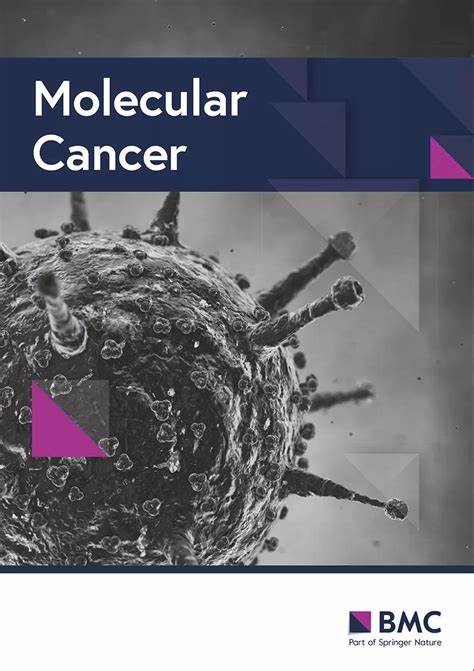环状 RNA 编码的致癌 PIAS1 变体通过调节 STAT1 的 SUMO 化和磷酸化之间的平衡阻断免疫性铁变态反应
IF 27.7
1区 医学
Q1 BIOCHEMISTRY & MOLECULAR BIOLOGY
引用次数: 0
摘要
尽管免疫检查点阻断疗法(ICB)在黑色素瘤中得到了广泛应用,但其临床反应率仍然很低。众所周知,环状非编码RNA(circRNA)在癌症进展中起着至关重要的作用,可能是限制ICB治疗效果的一个关键因素。通过RNA-seq和Ribo-seq鉴定了与单次给药PD-1抑制剂相比,联合给药后下调的circRNA,从而发现了具有高蛋白质编码潜力的circPIAS1(小鼠为mmu_circ_0015773,人类为has_circ_0008378)。荧光原位杂交(FISH)检测确定了 circPIAS1 在人和小鼠黑色素瘤细胞中的定位,以及在患者肿瘤和邻近组织中的存在。通过双荧光素酶报告实验和 LC-MS/MS 验证,证实 circPIAS1 能够编码一种新的 108 氨基酸多肽(circPIAS1-108aa)。针对 circPIAS1 的连接位点开发了特异性反义寡核苷酸 (ASO),以降低其细胞内水平。使用 CCK8、EdU 和集落形成试验评估了黑色素瘤细胞的增殖变化。通过GSH、MDA和C11-BODIPY染色试验研究了circPIAS1-108aa对黑色素瘤细胞铁变态过程的影响。研究人员采用了 Western 印迹、免疫沉淀(IP)和免疫沉淀-质谱(IP-MS)技术,研究 circPIAS1-108aa 对 P-STAT1/SLC7A11/GPX4 信号通路的影响,以及对 STAT1 SUMOylation 和磷酸化之间平衡的影响。此外,研究人员还利用黑色素瘤皮下移植肿瘤小鼠模型,考察了降低circPIAS1水平与PD-1抑制剂的联合作用。与单用PD-1抑制剂组相比,联合用药组的circPIAS1明显下调,并表现出更高的蛋白编码潜力。circPIAS1主要定位于细胞核,与邻近组织相比,它在肿瘤组织中明显上调,在促进癌细胞增殖方面起着至关重要的作用。这种 circRNA 可编码一种由 108 个氨基酸组成的独特多肽,通过这种多肽发挥促癌功能,并阻碍 ICB 治疗的有效性。从机理上讲,circPIAS1-108aa 通过招募 SUMO E3 连接酶 Ranbp2 来增强 STAT1 的 SUMO 化,从而阻碍 STAT1 的磷酸化,重新激活 SLC7A11/GPX4 信号通路的转导,限制 IFNγ 诱导的免疫性铁变态反应。此外,ASO-circPIAS1与PD-1抑制剂联合使用可有效抑制黑色素瘤的生长,并显著提高免疫药物在体内的疗效。我们的研究揭示了一种新的黑色素瘤免疫逃避机制,这种机制由黑色素瘤中circPIAS1编码的一种独特的108aa多肽驱动,它通过调节SUMO化和STAT1磷酸化之间的平衡,极大地阻碍了ICB疗法引发的免疫性铁突变。这项研究揭示了circPIAS1-108aa是限制黑色素瘤免疫治疗效果的一个关键因素,并提出了一种改善ICB治疗效果的可行策略。本文章由计算机程序翻译,如有差异,请以英文原文为准。
Circular RNA-encoded oncogenic PIAS1 variant blocks immunogenic ferroptosis by modulating the balance between SUMOylation and phosphorylation of STAT1
The clinical response rate to immune checkpoint blockade (ICB) therapy in melanoma remains low, despite its widespread use. Circular non-coding RNAs (circRNAs) are known to play a crucial role in cancer progression and may be a key factor limiting the effectiveness of ICB treatment. The circRNAs that were downregulated after coadministration compared with single administration of PD-1 inhibitor administration were identified through RNA-seq and Ribo-seq, and thus the circPIAS1 (mmu_circ_0015773 in mouse, has_circ_0008378 in human) with high protein coding potential was revealed. Fluorescence in situ hybridization (FISH) assays were conducted to determine the localization of circPIAS1 in human and mouse melanoma cells, as well as its presence in tumor and adjacent tissues of patients. Validation through dual-luciferase reporter assay and LC–MS/MS confirmed the ability of circPIAS1 to encode a novel 108 amino acid polypeptide (circPIAS1-108aa). Specific antisense oligonucleotides (ASOs) targeting the junction site of circPIAS1 were developed to reduce its intracellular levels. Proliferation changes in melanoma cells were assessed using CCK8, EdU, and colony formation assays. The impact of circPIAS1-108aa on the ferroptosis process of melanoma cells was studied through GSH, MDA, and C11-BODIPY staining assays. Western Blot, Immunoprecipitation (IP), and Immunoprecipitation-Mass Spectrometry (IP-MS) techniques were employed to investigate the impact of circPIAS1-108aa on the P-STAT1/SLC7A11/GPX4 signaling pathway, as well as its influence on the balance between STAT1 SUMOylation and phosphorylation. Additionally, a melanoma subcutaneous transplanted tumor mouse model was utilized to examine the combined effect of reducing circPIAS1 levels alongside PD-1 inhibitor. Compared with the group treated with PD-1 inhibitor alone, circPIAS1 was significantly down-regulated in the coadministration group and demonstrated higher protein coding potential. CircPIAS1, primarily localized in the nucleus, was notably upregulated in tumor tissues compared to adjacent tissues, where it plays a crucial role in promoting cancer cell proliferation. This circRNA can encode a unique polypeptide consisting of 108 amino acids, through which it exerts its cancer-promoting function and impedes the effectiveness of ICB therapy. Mechanistically, circPIAS1-108aa hinders STAT1 phosphorylation by recruiting SUMO E3 ligase Ranbp2 to enhance STAT1 SUMOylation, thereby reactivating the transduction of the SLC7A11/GPX4 signaling pathway and restricting the immunogenic ferroptosis induced by IFNγ. Furthermore, the combination of ASO-circPIAS1 with PD-1 inhibitor effectively inhibits melanoma growth and significantly enhances the efficacy of immune drugs in vivo. Our study uncovers a novel mechanism regarding immune evasion in melanoma driven by a unique 108aa peptide encoded by circPIAS1 in melanoma that dramatically hinders immunogenic ferroptosis triggered by ICB therapy via modulating the balance between SUMOylation and phosphorylation of STAT1. This work reveals circPIAS1-108aa as a critical factor limiting the immunotherapeutic effects in melanoma and propose a promising strategy for improving ICB treatment outcomes.
求助全文
通过发布文献求助,成功后即可免费获取论文全文。
去求助
来源期刊

Molecular Cancer
医学-生化与分子生物学
CiteScore
54.90
自引率
2.70%
发文量
224
审稿时长
2 months
期刊介绍:
Molecular Cancer is a platform that encourages the exchange of ideas and discoveries in the field of cancer research, particularly focusing on the molecular aspects. Our goal is to facilitate discussions and provide insights into various areas of cancer and related biomedical science. We welcome articles from basic, translational, and clinical research that contribute to the advancement of understanding, prevention, diagnosis, and treatment of cancer.
The scope of topics covered in Molecular Cancer is diverse and inclusive. These include, but are not limited to, cell and tumor biology, angiogenesis, utilizing animal models, understanding metastasis, exploring cancer antigens and the immune response, investigating cellular signaling and molecular biology, examining epidemiology, genetic and molecular profiling of cancer, identifying molecular targets, studying cancer stem cells, exploring DNA damage and repair mechanisms, analyzing cell cycle regulation, investigating apoptosis, exploring molecular virology, and evaluating vaccine and antibody-based cancer therapies.
Molecular Cancer serves as an important platform for sharing exciting discoveries in cancer-related research. It offers an unparalleled opportunity to communicate information to both specialists and the general public. The online presence of Molecular Cancer enables immediate publication of accepted articles and facilitates the presentation of large datasets and supplementary information. This ensures that new research is efficiently and rapidly disseminated to the scientific community.
 求助内容:
求助内容: 应助结果提醒方式:
应助结果提醒方式:


